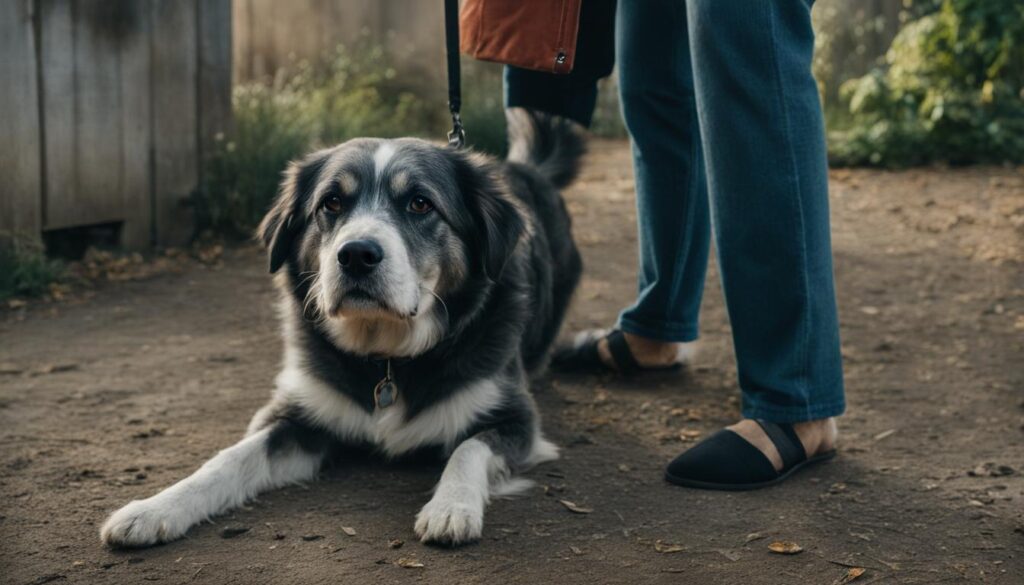As a dog owner, you may have experienced the peculiar behavior of your furry friend laying on your feet. While it may seem puzzling at first, this canine behavior actually has several meaning and motivations behind it. Understanding why dogs lay on feet can provide valuable insights into their body language, psychology, and the unique bond they share with their owners.
Dogs laying on their owner’s feet is often a display of affection and a way for them to show their love and bond with their human companions. It’s their way of saying, “I adore you, and I want to be close to you.” This physical closeness allows them to feel secure and connected, strengthening the emotional connection between you and your faithful canine companion.
In addition to affection, dogs may also lay on feet for practical reasons. One of these reasons is seeking security. Dogs are social animals and rely on their owners for protection and reassurance. By resting on your feet, they find comfort and a sense of safety, especially in unfamiliar environments or during anxious situations.
Another possible reason behind this behavior is guarding and protecting. Dogs have a natural instinct to protect their loved ones and territory. Sitting on your feet can be a way for them to mark their ownership and warn other dogs to stay away. It’s their way of saying, “This human is mine, and I’ll guard them with all my loyalty.”
Moreover, dogs may choose to lay on feet for warmth and comfort. Just as puppies huddle together for warmth and security, sitting on feet allows them to seek the warmth of their owner’s body heat, particularly in colder weather. It’s a cozy and instinctual gesture that brings them comfort and a sense of well-being.
Furthermore, sitting on feet is a manifestation of the strong bond and companionship dogs feel towards their owners. By being physically close and connected, dogs satisfy their social nature and emotional needs. It’s their way of being a part of your everyday life and demonstrating their unwavering loyalty and love.
Lastly, dogs have an incredible ability to sense human emotions. They often sit on their owner’s feet as a comforting gesture, especially when you’re feeling sad or unwell. They offer solace and companionship, providing you with their support and unconditional love, simply by being present and sharing their warmth.
So, the next time your beloved dog lays on your feet, remember that it’s a multifaceted behavior driven by affection, security, protection, warmth, companionship, and empathy. Embrace their presence and cherish the unique bond you share with these incredible creatures.
Key Takeaways:
- Dogs lay on their owner’s feet as a display of affection and to strengthen the bond between them.
- It can also be a way for dogs to seek security and comfort, especially in new or anxious situations.
- This behavior may indicate the dog’s instinct to guard and protect their owner.
- Seeking warmth and companionship are also motivations behind dogs laying on feet.
- Dogs can sense human emotions and may sit on feet to provide comfort and support.
The Affectionate Gesture of Sitting on Feet
When a dog sits on their owner’s feet, it is often a display of affection and a way for the dog to feel close to their owner. This behavior can be seen as a canine version of a hug or cuddle. Dogs of all ages, sizes, breeds, and genders may choose to sit on their owner’s feet as a way to show their love and desire to stay close to their owners.
Sitting on their owner’s feet allows dogs to feel connected and bonded with their human companions. It is an affectionate gesture that strengthens the dog-owner relationship and fosters a sense of intimacy. Dogs feel secure and content when they can be physically close to their owners, and sitting on feet is one way they seek that closeness.
Furthermore, sitting on feet can provide dogs with a sense of comfort and warmth. By positioning themselves in close proximity, dogs can benefit from their owner’s body heat, making them feel safe and cozy. This behavior mimics a natural inclination for dogs to seek warmth and companionship from their pack members in the wild.
“When my dog sits on my feet, it’s like a warm embrace. It makes me feel loved and cherished. I know it’s his way of showing his affection and deep connection to me. It’s a special bond we share.”
– Rebecca, dog owner
Seeking Security Through Foot Sitting

Dogs have a remarkable ability to sense when they are in unfamiliar territory or faced with anxiety-inducing situations. In these moments, dogs may turn to their owners for security and comfort, sometimes resorting to sitting on their feet. This behavior demonstrates their instinctual need for reassurance and protection.
Anxious dog behavior can manifest in various ways, and sitting on their owner’s feet is one way dogs seek solace. By physically connecting with their owner, dogs feel safer and more secure, knowing that their human companion will provide the support and comfort they need.
This behavior can be especially prevalent when dogs are in new environments or situations where they may feel overwhelmed or vulnerable. Whether experiencing separation anxiety when left alone or facing fear in a crowded space, dogs may naturally gravitate towards their owner’s feet to find a sense of security.
From a dog’s perspective, sitting on their owner’s feet allows them to establish a physical bond and connection. This proximity to their owner’s presence creates a feeling of safety and protection, soothing their anxious minds.
Additionally, dog body language can reveal their anxiety. Signs such as panting, pacing, trembling, and avoiding eye contact may accompany the tendency to sit on their owner’s feet. Understanding these cues and behaviors is essential for dog owners to provide the necessary support and reassurance to their furry companions.
The act of sitting on their owner’s feet is a coping mechanism for dogs facing stress or fear, making them feel safer and reassured.
To better understand an anxious dog’s behavior, it is crucial to respond with patience and empathy. Encouraging positive reinforcement, engaging in calming exercises, and providing a safe, quiet space are all ways to alleviate their anxiety and help them feel secure.
| Signs of Anxious Dog Behavior | Ways to Provide Comfort and Security |
|---|---|
|
|
By addressing their anxiety and providing the necessary support, dog owners can help their furry friends find a sense of security and overcome their anxious behaviors. Remember, every dog is unique, so it’s essential to observe their individual body language and respond accordingly to their needs.
Guarding and Protecting Behavior

Some dogs exhibit a unique behavior of sitting on their owner’s feet as a way to guard and protect them. This action serves as a territorial display, where the dog marks their owner as their own and warns other dogs to stay away. By positioning themselves on their owner’s feet, dogs assert their ownership and loyalty, creating a physical barrier between their owner and potential threats.
The behavior can also be interpreted as a display of the strong bond and protective nature that dogs have towards their owners. Dogs are known for their loyalty and innate instincts to protect their pack members, and sitting on their owner’s feet reinforces this natural guarding behavior.
It’s essential to recognize the dog’s body language when they exhibit this behavior. They may appear alert, with their ears perked up, and a focused gaze towards their surroundings. This stance signals their readiness to defend their owner against any perceived threats.
To better understand this guarding and protecting behavior, it’s important to be aware of common dog body language cues such as raised hackles, direct eye contact, and a stiff posture. These cues indicate that the dog is ready to take action if necessary.
Signs of Guarding and Protecting Behavior:
- Positioning themselves on their owner’s feet
- Raised hackles
- Direct eye contact
- Stiff posture
It’s important to note that while some dogs may exhibit guarding behavior towards their owners, it is essential to ensure that this behavior does not become possessive or aggressive. Seek professional guidance if you notice any concerning behavior in your dog’s protective tendencies.
| Pros | Cons |
|---|---|
| Provides a sense of security for the owner | Possibility of possessive or aggressive behavior |
| Reinforces the bond and loyalty between dog and owner | May make guests or unfamiliar individuals uncomfortable |
| Acts as a deterrent to potential threats | Potential for unintentional reinforcement of guarding behavior |
Seeking Warmth and Comfort

During cold or damp weather, dogs often seek warmth and comfort by sitting on their owner’s feet. This behavior is instinctual, mimicking the way puppies huddle together for warmth and a sense of security. By sitting on their owner’s feet, dogs can benefit from the body heat and find comfort in the close proximity.
This innate behavior is deeply rooted in the canine instinct to stay warm and protected in chilly conditions. Dogs rely on their owners’ body heat to regulate their own body temperature, especially when exposed to the cold weather. The act of sitting on feet provides dogs with the physical warmth they need to stay comfortable and cozy.
In addition to seeking warmth, sitting on their owner’s feet also offers dogs a sense of security. It allows them to feel close to their trusted human companion, providing a source of comfort and reassurance. This behavior not only keeps them warm but also strengthens the bond between dogs and their owners.
It’s essential for dog owners to understand the body language of their pets. When dogs choose to sit on their owners’ feet in cold weather, it’s a clear indication that they are seeking warmth and comfort. By recognizing and responding to this behavior, owners can ensure their dogs’ well-being and provide the warmth and security they need in harsh weather conditions.
| Benefits of Dogs Sitting on Owner’s Feet in Cold Weather |
|---|
| 1. Physical warmth and comfort |
| 2. Sense of security and reassurance |
| 3. Strengthening the bond between dogs and owners |
Canine Companionship and Bonding

Sitting on their owner’s feet is not just a random behavior for dogs; it serves a deeper purpose in establishing a strong bond and companionship between dogs and their human family members. Dogs are inherently social animals, and they actively seek connection with their owners. By sitting on their owner’s feet, dogs communicate their desire to be close, their sense of security, and their emotional connection.
This behavior is a display of trust and affection, as dogs feel safe and protected when they are in close proximity to their owners. It is a sign that they trust their human companion and view them as a source of comfort and support.
Companionship with dogs goes beyond the physical aspect; it is an emotional connection that is strengthened through shared experiences and interactions. Dogs have an incredible ability to understand human emotions, providing unconditional love and support when their owners are feeling down or stressed.
It’s important to pay attention to a dog’s body language when they sit on their owner’s feet. This behavior can indicate their desire for attention, affection, or a sense of security. Understanding dog body language is crucial for dog owners to interpret their canine companions’ needs and emotions.
To showcase the significance of dog-human bonding and companionship, here is an example of a heartwarming story:
“Every evening, when I come home from work, my loyal Golden Retriever, Max, greets me at the door with a wagging tail and immediately sits on my feet. It’s his way of telling me that he missed me and that he’s glad I’m home. This simple gesture reinforces the bond we share and makes me feel loved and appreciated. Max has become not just a pet, but a true companion who brings joy and happiness to my life.”
By nurturing the bond between dogs and their owners, we can create a harmonious and fulfilling relationship that brings mutual happiness and support. Dogs are truly remarkable creatures, capable of enriching and enhancing our lives in countless ways.
Dogs Sensing Human Emotions

Dogs possess an uncanny ability to sense human emotions, allowing them to provide comfort and support in times of sadness or distress. When their owners are feeling down or unwell, dogs may exhibit a comforting behavior by sitting on their owners’ feet, offering a source of emotional solace and a feeling of closeness. This empathetic response speaks volumes about the bond between humans and their canine companions.
This instinctual behavior can be particularly evident in multi-dog households where dogs may engage in a subtle form of competition for their owner’s attention and proximity. For some dogs, sitting on their owner’s feet becomes a strategic way to assert their presence and garner attention from their beloved humans.
Dogs communicate their empathy and emotional awareness primarily through their body language. By sitting on their owner’s feet, they are not only expressing empathy but also seeking physical and emotional connection, using their presence as a means of providing comfort and establishing a stronger bond.
| Benefits of Dogs Sensing Human Emotions |
|---|
| 1. Emotional support: Dogs offering their presence and companionship can provide immense emotional support to owners experiencing sadness or distress. |
| 2. Forming a deeper bond: Sitting on their owner’s feet allows dogs to physically connect with their human companion, fostering a stronger sense of mutual understanding and trust. |
| 3. Strengthening the human-animal relationship: By demonstrating empathy and comforting behavior, dogs reinforce the emotional connection between humans and canines, solidifying their significance as cherished companions. |
Through their innate ability to sense and respond to human emotions, dogs contribute to the overall well-being and happiness of their owners, showcasing the remarkable depths of the human-canine bond.
Arthritic Dogs and Raised Position

Arthritic dog behavior can often be influenced by the need for comfort and pain relief. Senior dogs with joint issues may choose to sit on their owner’s feet as a means of finding relief in a raised position. By sitting on their owner’s feet, arthritic dogs can avoid bending down or exerting pressure on their painful joints, which can cause discomfort and pain.
This behavior is an instinctual response for dogs experiencing joint pain, as they naturally seek out positions that provide them with support and reduce strain on their bodies. Sitting on their owner’s feet helps them find a raised and stable platform that alleviates pressure on their arthritic joints, allowing them to rest more comfortably.
Additionally, sitting on their owner’s feet can serve as a source of emotional support and security for arthritic dogs. The physical contact and closeness to their owner can provide a sense of comfort and reassurance, which can help ease their anxiety and stress associated with their condition.
Dogs sitting on their owner’s feet can be a sign that their joint health needs attention and care. It is important for dog owners to provide appropriate joint supplements, maintain a healthy weight for their arthritic dog, and provide a comfortable and supportive environment that promotes their overall well-being.
| Benefits of Dogs Sitting on Feet for Arthritic Dogs | |
|---|---|
| 1. | Relieves pressure on arthritic joints |
| 2. | Provides stability and support |
| 3. | Helps alleviate discomfort and pain |
| 4. | Offers emotional support and reassurance |
Anxiety and Seeking Reassurance
Dogs experiencing anxiety, whether due to separation anxiety or fear of new environments, may choose to sit on their owner’s feet for comfort and reassurance. This behavior helps them feel safe and protected, as they rely on their owner’s presence to alleviate their anxiety.
Separation anxiety is a common issue among dogs, especially when they are left alone for extended periods. Dogs with separation anxiety may exhibit destructive behavior, excessive barking, or even self-harm. Sitting on their owner’s feet can provide them with a sense of security and alleviate their anxiety by being close to the person they trust the most.
In addition to separation anxiety, dogs may also feel anxious in unfamiliar environments or during stressful situations. These can include visits to the veterinarian, car rides, or encountering new people or animals. Sitting on their owner’s feet allows dogs to seek comfort and reassurance, providing them with a familiar and safe space amidst the anxiety-provoking situation.
It’s important for dog owners to pay attention to their pet’s body language when they exhibit anxious behaviors like sitting on their feet. Dogs may display signs of anxiety such as panting, trembling, excessive drooling, or avoiding eye contact. By recognizing these signs and providing reassurance, owners can help their dogs feel more secure and reduce their anxiety levels.
“When dogs sit on their owner’s feet during anxiety-inducing situations, it’s their way of seeking comfort and reassurance. They rely on their owner’s presence to feel safe and protected.”
Understanding and addressing dog anxiety is crucial for their overall well-being. If a dog exhibits persistent anxiety or distress, it’s recommended to consult a veterinarian or a professional dog trainer specialized in anxiety-related behaviors. Proper training, socialization, and desensitization techniques can help dogs overcome their anxiety and lead happier, stress-free lives.
Providing dogs with a secure and loving environment is essential to their mental and emotional health. By supporting and comforting our furry friends when they need it most, we can strengthen our bond with them and help them feel safe and reassured in times of anxiety.
Dogs Following Their Owners
Some dogs have a strong attachment to their owners and exhibit a behavior known as “velcro dogs”. These dogs feel more secure when they can keep a close eye on their owners and prevent separation anxiety. One way they accomplish this is by sitting on their owners’ feet, maintaining proximity and a sense of connection.
This behavior is particularly common among dogs with separation anxiety, a condition in which dogs experience distress and anxiety when separated from their owners. By sitting on their owners’ feet, these dogs can alleviate some of their anxiety and feel more secure in their presence. It serves as a coping mechanism to prevent the onset of separation anxiety symptoms.
In addition to preventing separation anxiety, sitting on their owners’ feet also allows dogs to closely observe their surroundings. By sitting at their owners’ feet, dogs have a vantage point to monitor their environments and ensure that their owners don’t wander too far away. This behavior enables them to fulfill their natural instinct of staying close to their pack leader and provides a sense of reassurance.
Dogs Seeking Owner’s Attention
Dogs are incredibly social animals that seek attention and affection from their owners. One attention-seeking behavior that dogs may exhibit is sitting on their owner’s feet. This behavior is often accompanied by a deliberate display of body language intended to capture their owner’s attention.
When a dog sits on their owner’s feet, they are essentially saying, “Look at me! I want your attention!” This behavior is a clever way for dogs to ensure they receive extra pampering, petting, and ear rubs from their beloved owner. The close physical proximity reinforces the bond between the dog and their caregiver, creating a sense of security and love.
Not only do dogs enjoy the physical contact and affection, but they also thrive on the positive reinforcement that comes with their attention-seeking behavior. Every time a dog sits on their owner’s feet and receives attention, they are more likely to repeat this behavior in the future to gain even more attention and affection.
This attention-seeking behavior also calls for an understanding of dog body language. Dogs may use a variety of cues, such as wagging their tails, licking their lips, or making direct eye contact, to communicate their desire for attention. It is important for dog owners to recognize and respond to these cues appropriately, providing the attention and affection that their furry friend seeks.
“Dogs have a natural instinct to seek attention and companionship from their owners. Sitting on their feet is one way they communicate that desire for attention.”
– Dr. Sarah Adams, Canine Behavior Specialist
You might also enjoy:
- Understanding Dog Body Language: A Guide for Pet Owners
- The Science Behind the Canine-Human Bond
- Top 5 Attention-Seeking Behaviors in Dogs: How to Address Them
Wrapping Up
Dogs sitting on their owner’s feet can exhibit various behaviors that can provide insights into their psychology, emotions, and the nature of their bond with their owners. This seemingly simple act can convey affection, seek security, display loyalty, and provide warmth and comfort for both the dog and the owner.
Understanding the reasons behind this behavior allows dog owners to cultivate a deeper connection with their furry companions. By recognizing their dog’s body language and interpreting their actions, owners can respond appropriately to ensure their dog’s well-being and happiness.
This behavior reflects the strong bond between dogs and their human owners. It exemplifies the unique companionship and emotional connection that can blossom through dog ownership. By nurturing this bond and acknowledging the intricate nuances of their dog’s behavior, owners can create a harmonious and loving environment for their four-legged friends.
FAQ
Why does my dog lay on my feet?
Dogs lay on their owners’ feet for various reasons, including displaying affection, seeking security, and guarding their owners. It can also provide warmth and comfort for the dog.
What does it mean when a dog sits on their owner’s feet?
When a dog sits on their owner’s feet, it is often a display of affection and a way for the dog to feel close to their owner. It can also be a sign of seeking security and guarding their owner.
Why do dogs sit on their owner’s feet for warmth?
Dogs may choose to sit on their owner’s feet, especially in cold or damp weather, to seek warmth and stay cozy. This behavior is instinctual and can provide them with the comfort and heat they need to stay comfortable in chilly conditions.
Is it normal for dogs to sit on their owner’s feet?
Yes, it is normal for dogs to sit on their owner’s feet. It is a way for dogs to establish a strong bond and companionship with their owners. It can also provide them with a sense of security and comfort.
Why do some dogs sit on their owner’s feet more than others?
Some dogs may have a stronger attachment to their owners, and they may choose to sit on their feet as a way to stay close and prevent separation anxiety. These dogs often feel more secure when they can keep an eye on their owner and feel connected.
Does sitting on their owner’s feet provide any health benefits for dogs?
For arthritic dogs, sitting on their owner’s feet allows them to be in a raised position without exerting pressure on their joints. This behavior can provide them with comfort and alleviate any discomfort or pain they may be experiencing.
Can dogs sense human emotions when they sit on their owner’s feet?
Yes, dogs have a remarkable ability to sense human emotions, especially when their owners are feeling sad or unwell. Sitting on their owner’s feet can be a comforting gesture, providing emotional support and a sense of closeness.
How can I tell if my dog is sitting on my feet for attention?
Dogs may sit on their owner’s feet as an attention-seeking behavior. If your dog sits on your feet and receives extra attention, petting, and ear rubs, it can be a sign that they are seeking your attention and affection.
What should I do if my dog constantly sits on my feet?
If your dog constantly sits on your feet, it is important to understand the underlying reasons for this behavior. It can be a sign of seeking security, warmth, attention, or companionship. Responding to your dog’s needs and providing them with comfort and reassurance can help alleviate this behavior.
How can understanding my dog’s body language help in interpreting their sitting on my feet?
Understanding your dog’s body language is crucial in interpreting their behavior, including why they sit on your feet. By observing their overall posture, tail wagging, ear position, and eye contact, you can gain insight into their emotions and motivations.






